The MSI B350 Tomahawk Motherboard Review: Gaming On a Budget
by Gavin Bonshor on March 12, 2018 10:45 AM EST- Posted in
- Motherboards
- AMD
- MSI
- ATX
- Zen
- AM4
- B350
- Ryzen
- Tomahawk
- Raven Ridge
System Performance
Not all motherboards are created equal. On the face of it, they should all perform the same and differ only in the functionality they provide - however, this is not the case. The obvious pointers are power consumption, but also the ability for the manufacturer to optimize USB speed, audio quality (based on audio codec), POST time and latency. This can come down to manufacturing process and prowess, so these are tested.
Power Consumption
Power consumption was tested on the system while in a single ASUS GTX 980 GPU configuration with a wall meter connected to the Thermaltake 1200W power supply. This power supply has ~75% efficiency > 50W, and 90%+ efficiency at 250W, suitable for both idle and multi-GPU loading. This method of power reading allows us to compare the power management of the UEFI and the board to supply components with power under load, and includes typical PSU losses due to efficiency. These are the real world values that consumers may expect from a typical system (minus the monitor) using this motherboard.
While this method for power measurement may not be ideal, and you feel these numbers are not representative due to the high wattage power supply being used (we use the same PSU to remain consistent over a series of reviews, and the fact that some boards on our test bed get tested with three or four high powered GPUs), the important point to take away is the relationship between the numbers. These boards are all under the same conditions, and thus the differences between them should be easy to spot.
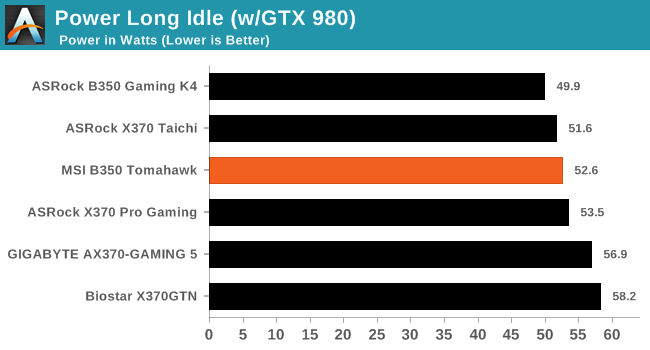

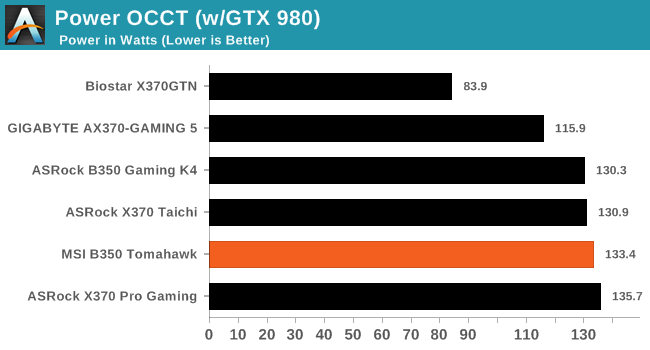
On the whole when compared to the other X370/B350 motherboards on test, the MSI B350 Tomahawk sits relatively average. At load however, there are no real advantages to being a budget B350 board.
Non-UEFI POST Time
Different motherboards have different POST sequences before an operating system is initialized. A lot of this is dependent on the board itself, and POST boot time is determined by the controllers on board (and the sequence of how those extras are organized). As part of our testing, we look at the POST Boot Time using a stopwatch. This is the time from pressing the ON button on the computer to when Windows starts loading. (We discount Windows loading as it is highly variable given Windows specific features.)
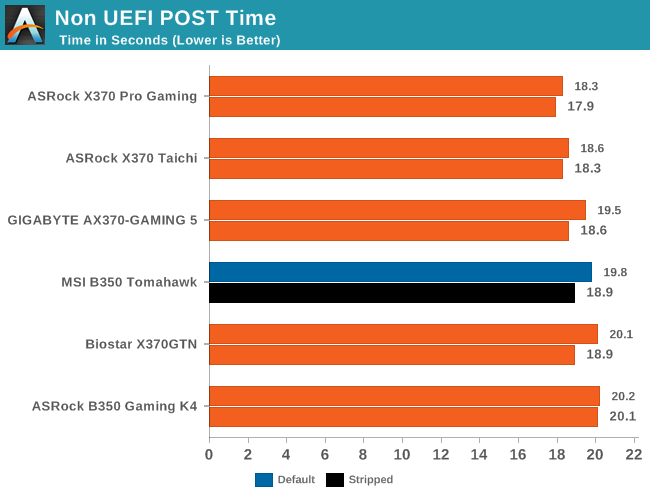
Most of the POST times on X370 seem to be in the same ball-park, differing by a second or two for the most part.
Rightmark Audio Analyzer 6.2.5
Rightmark:AA indicates how well the sound system is built and isolated from electrical interference (either internally or externally). For this test we connect the Line Out to the Line In using a short six inch 3.5mm to 3.5mm high-quality jack, turn the OS speaker volume to 100%, and run the Rightmark default test suite at 192 kHz, 24-bit. The OS is tuned to 192 kHz/24-bit input and output, and the Line-In volume is adjusted until we have the best RMAA value in the mini-pretest. We look specifically at the Dynamic Range of the audio codec used on the rear panel of the board.
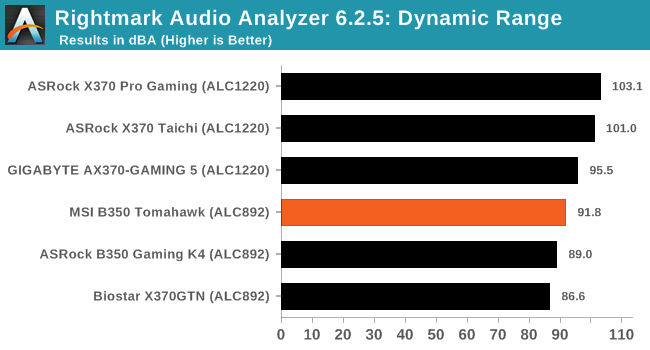
In an expected showing, the Realtek ALC892 comes reasonably close to the ALC1220 options, but can't hit the high.
DPC Latency
Deferred Procedure Call latency is a way in which Windows handles interrupt servicing. In order to wait for a processor to acknowledge the request, the system will queue all interrupt requests by priority. Critical interrupts will be handled as soon as possible, whereas lesser priority requests such as audio will be further down the line. If the audio device requires data, it will have to wait until the request is processed before the buffer is filled.
If the device drivers of higher priority components in a system are poorly implemented, this can cause delays in request scheduling and process time. This can lead to an empty audio buffer and characteristic audible pauses, pops and clicks. The DPC latency checker measures how much time is taken processing DPCs from driver invocation. The lower the value will result in better audio transfer at smaller buffer sizes. Results are measured in microseconds.
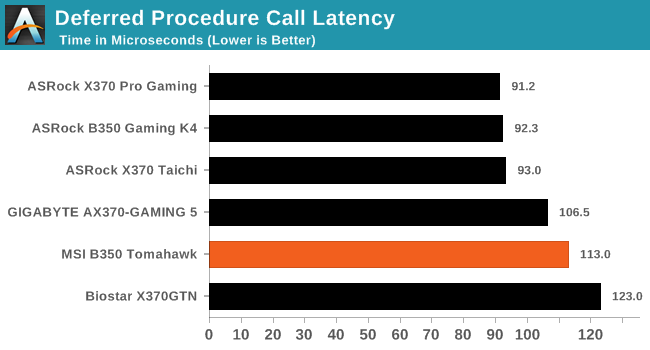
None of the boards tested thus far have been optimised for DPC latency, although all of the test boards managed to squeeze under 150 microseconds with relative ease. The B350 Tomahawk does fall behind from the ASRock boards in our testing by around 21 microseconds; not a massive difference in real world scenarios however.










46 Comments
View All Comments
Ket_MANIAC - Tuesday, March 13, 2018 - link
Only 3 AM4 motherboard reviews in over a year?evancox10 - Wednesday, March 14, 2018 - link
s/compliment/complement/If something is free, it is complimentary. If two or more things combine together well, they are complementary.
Daisy81 - Saturday, August 11, 2018 - link
I currently have Ryzen 5 1660, MSI B350 Tomahawk and a 16GB kit of PNY Anarchy DDR4-2400 RAM (2x8). These three pieces I got for $480 with tax about a month ago. I wasn't expecting much but it out of the box was way faster then my antiquated Asus P5Q-E, Core 2 Quad Q9650 and 8GB DDR2,Anyways I am very impressed with all of these pieces as a whole. The memory runs at DDR4-3066 speeds on this motherboard. The CPU is solid as a rock at 4GHz on this motherboard. In fact on this motherboard pushing the clock speed to 4.05GHz for benching (using the stock cooler that came with the processor no less) my Ryzen 5 1600 on the B350 Tomahawk beat my Core i7 5930K on a MSI X99A SLI Plus in the CPU department. This blows me away because these three components cost me on par for what I purchased my 5930K new at Microcenter for.
A link for the 3D Mark Timespy results results
https://www.3dmark.com/compare/spy/4202900/spy/100...